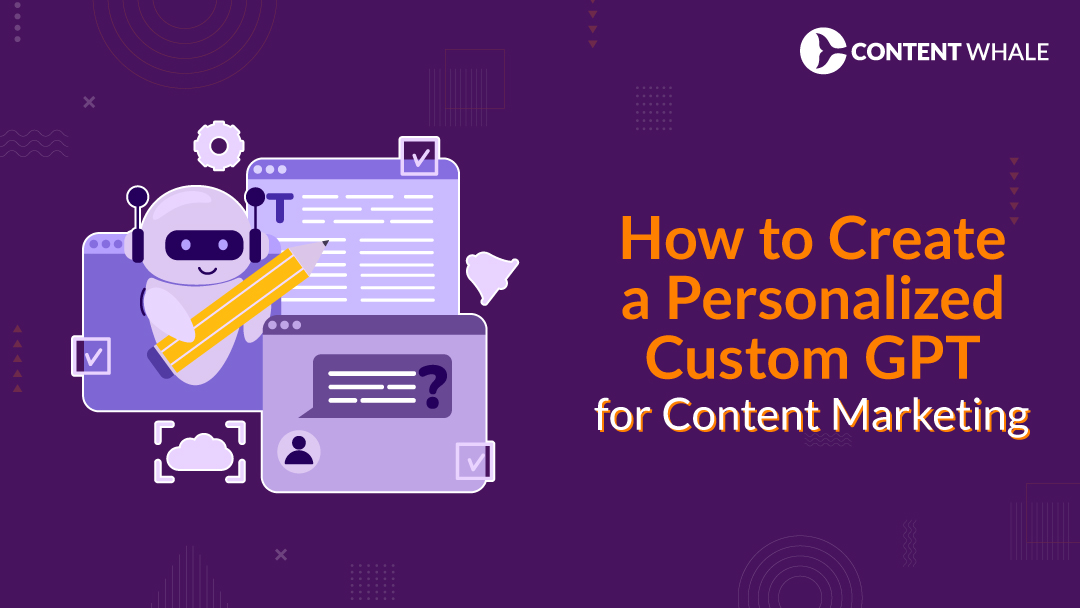How can a custom GPT specifically designed for your content marketing make a difference? Whether your goal is to enhance customer engagement, boost lead generation, or simplify your content workflow, a personalized GPT powered by GPT-4 offers significant advantages.
Traditional content creation methods often demand considerable time and resources. With AI content marketing, you can automate and personalize your content in previously unimaginable ways. From audience research to developing buyer personas, AI tools can revolutionize how you understand and connect with your audience.
Using GPT for content strategy means creating meaningful, engaging, and relevant content that speaks directly to your readers. By setting clear content goals and leveraging advanced AI tools like GPT-4, you can develop a strategy that is both efficient and effective.
When considering personalized marketing strategies, think about how a custom GPT can embody your brand’s voice. This goes beyond simple text generation; achieving brand voice consistency across all platforms. Whether it’s blog posts, social media updates, or email marketing, a well-tuned GPT ensures your content is always on point.
To get started, it’s important to understand the various GPT models available. Selecting the right GPT model involves evaluating your content data and preparing it meticulously. This includes data preprocessing and organizing your training data for optimal results. Fine-tuning GPT is where the real customization happens – aligning the AI with your specific content goals.
Once your GPT model is trained, the next step is to integrate GPT into your content workflow. Testing GPT is essential to ensure it meets your standards before full deployment. Continuous monitoring and analyzing performance metrics are crucial to maintaining and improving the quality of your AI-driven content. Embracing AI best practices and ensuring ethical AI use will guarantee responsible AI use in your content strategy.
In the following sections, we’ll examine each step in detail, providing actionable tips and insights to help you create a personalized GPT that enhances your content marketing. Whether you’re a seasoned marketer or just starting, this guide will equip you with the knowledge and tools to leverage GPT-4 for high-quality content generation and AI-driven marketing.
Step 1: Define Your Content Marketing Goals
What do you want to achieve with your content marketing efforts? Setting clear and specific content goals is the first step toward effectively utilizing a custom GPT for your marketing strategy. These goals will guide your AI content marketing efforts and ensure that the content generated by your personalized GPT aligns with your overall business objectives.
Understanding Your Target Audience
To create content that truly engages, you need to understand your target audience. Conducting thorough audience research helps in identifying the needs, preferences, and pain points of your audience. This information is crucial for tailoring your content to meet their expectations.
- Audience Research: Use surveys, social media insights, and analytics tools to gather data about your audience. Look at demographics, interests, and behavior patterns to get a comprehensive understanding.
- Buyer Personas: Develop detailed buyer personas based on your research. These personas represent your ideal customers and help you create content that speaks directly to them.
Setting Specific, Measurable Goals
Clear, specific goals are essential for any content strategy. Using the SMART criteria (Specific, Measurable, Achievable, Relevant, Time-bound) ensures your goals are well-defined and attainable.
- Increase Engagement: Aim to improve metrics such as likes, shares, comments, and time spent on page.
- Boost Lead Generation: Set targets for the number of leads generated through content.
- Enhance Brand Awareness: Track increases in brand mentions, social media followers, and website traffic.
Examples of Content Marketing Goals
Here are some practical examples of content marketing goals that can guide your strategy:
- Generate 100 new leads per month through blog content.
- Increase website traffic by 50% in the next six months.
- Boost social media engagement by 20% by the end of the quarter.
Actionable Tips
- Conduct Surveys and Interviews: Engage with your audience directly through surveys and interviews to gather qualitative insights.
- Analyze Competitor Content: Look at what competitors are doing to engage their audience. Identify gaps and opportunities for your own content.
- Use Analytics Tools: Tools like Google Analytics, SEMrush, and social media analytics provide valuable data on audience behavior and content performance.
By setting clear content goals and understanding your target audience, you lay a solid foundation for your GPT for content strategy. These steps ensure that your AI-powered content is not only relevant but also effective in achieving your marketing objectives.
In the next section, we’ll explore how to select the right GPT models for your needs, ensuring your personalized GPT is perfectly tailored to your content marketing goals.
Step 2: Select the Right GPT-4 Model
Choosing the right GPT models is essential to effectively leveraging AI content marketing for your needs. This decision impacts how well your personalized GPT will perform and how seamlessly it integrates into your content workflow.
Sadly, We Can’t Use GPT-4o Yet
Unfortunately, OpenAI’s latest model, GPT-4o, is not available for creating custom GPTs at the moment. So, we’ll be using GPT-4 as the base model for our custom GPT. Despite this limitation, GPT-4 is still a highly advanced language model that excels in text generation, natural language processing (NLP), and creating AI-powered content.
Overview of GPT-4 Capabilities
GPT-4 has a wide range of capabilities that make it an excellent choice for content marketing:
- Text Generation: GPT-4 can create high-quality content for blogs, social media, emails, and more.
- NLP: It understands and processes natural language inputs, making it highly effective for content personalization.
- Content Optimization: With its advanced algorithms, GPT-4 can help optimize content for better engagement and performance.
Choosing the Right Model Based on Your Needs
When selecting the right GPT model, consider your specific content marketing goals and the type of content you want to produce. Here are a few factors to guide your decision:
- Content Data: Evaluate the volume and variety of content data you have. More diverse data can help in training a more robust model.
- Data Preparation: Ensure your data is well-organized and relevant. Proper data preprocessing is critical for effective AI training.
- Training Data: The quality of your training data will directly impact the performance of your custom GPT. Use high-quality, representative samples.
Cost Considerations
Budget is an important factor when choosing a GPT-4 model. Standard models may be sufficient for basic content needs, while fine-tuned models provide higher accuracy and customization at a higher cost.
- Standard vs. Fine-Tuned Models: Standard models are less expensive but may require more manual adjustments. Fine-tuned models, while costlier, offer better alignment with your specific content goals and brand voice consistency.
Actionable Tips
- Evaluate Different Models: Test multiple GPT models by generating sample content to see which best meets your needs.
- Compare Costs and Benefits: Weigh the cost of fine-tuning against the potential benefits of improved content quality and customer engagement.
- Use High-Quality Data: Invest time in data preparation and ensure your training data is accurate and relevant.
By carefully selecting the right GPT-4 model, you ensure your AI content marketing efforts are efficient and effective. The next step is to fine-tune GPT to match your brand’s voice and content goals perfectly. This will be covered in the following section, guiding you through the process of AI training and customization.
Step 3: Customize the GPT-4 Model
Creating a custom GPT tailored to your specific needs is where the real power of AI content marketing comes into play. By fine-tuning GPT to reflect your brand’s voice and meet your content goals, you can ensure that your personalized GPT delivers high-quality, engaging content.
Fine-Tuning the Model with Your Data
Fine-tuning GPT involves training the model using your specific content data. This step is crucial as it allows the AI to learn and adapt to the nuances of your brand’s voice and the preferences of your target audience.
- Data Preparation: Gather a comprehensive set of training data that represents the type of content you want your GPT to generate. This can include blog posts, social media updates, product descriptions, and more.
- Data Preprocessing: Ensure your data is clean and well-organized. Remove any irrelevant or duplicate content and format the data consistently.
- AI Training: Use the prepared data to train GPT. This involves running the model through multiple iterations to refine its understanding and improve its performance.
Incorporating Your Brand Voice and Style
To achieve brand voice consistency, it’s essential to train your custom GPT to mimic the tone, style, and vocabulary unique to your brand. This helps in creating a seamless experience for your audience across all content platforms.
1. Define Guidelines:

- Identify Key Elements: List the key elements that define your brand’s voice (e.g., formal, casual, friendly, authoritative).
- Tone and Style: Specify the tone (e.g., professional, humorous) and style (e.g., concise, descriptive) that should be used.
- Vocabulary: Compile a list of preferred words and phrases, as well as any terms to avoid.
- Formatting Rules: Set rules for content structure, such as the use of headings, bullet points, and paragraph length.
- Review and Approve: Have stakeholders review the guidelines to ensure alignment with the brand’s identity.
2. Example Content:

- Select High-Quality Samples: Choose a diverse set of existing content that best represents your brand’s voice. This could include top-performing blog posts, social media updates, and marketing emails.
- Annotate Key Features: Highlight and annotate key features in each sample that align with your brand’s voice guidelines, such as tone, style, and vocabulary.
- Organize by Category: Group the examples by content type (e.g., blogs, emails, social media) for easy reference during training.
- Provide Context: Add context to each example, explaining why it aligns with your brand voice and how it achieves your content goals.
- Use for Training: Incorporate these annotated examples into the training data to help the GPT model learn and replicate your brand’s voice.
3. Creating Custom Prompts and Responses

Customizing the prompts and responses that your personalized GPT generates is a critical step in ensuring the AI delivers relevant and engaging content.
- Custom Prompts: Develop a variety of prompts that the GPT can use to generate content. These prompts should align with your content goals and the interests of your target audience.
- Testing GPT: Run tests to see how well the model generates content based on these prompts. Make adjustments as necessary to improve the quality and relevance of the responses.
4. Actionable Tips

- Use Diverse Training Data: Ensure your training data includes a wide range of content types and topics to give the GPT a well-rounded understanding.
- Regularly Update the Model: Keep your model updated with new data to reflect changes in your brand’s voice or content strategy.
- Monitor and Optimize: Continuously monitor GPT performance and make adjustments based on performance metrics to keep improving the quality of the generated content.
By thoroughly customizing your GPT-4 model, you ensure that your AI content marketing efforts are tailored to your brand and your audience’s needs. This not only enhances the relevance and engagement of your content but also strengthens your overall content marketing strategy.
Next, we’ll explore how to integrate GPT into your content workflow, ensuring a smooth and effective implementation of your personalized GPT. This includes setting up automated workflows, AI content testing, and continuous performance monitoring.
Step 4: Integrate the Custom GPT into Your Content Strategy
Integrating your custom GPT into your content strategy is where you start seeing the tangible benefits of your AI content marketing efforts. This step ensures that your personalized GPT works seamlessly within your existing processes and enhances your overall marketing strategy.
Identifying Touchpoints for GPT Integration
To maximize the impact of your custom GPT, identify the key touchpoints where it can be most effective. These touchpoints are the places where your audience interacts with your content, and leveraging GPT here can significantly enhance engagement.
- Website: Use GPT to generate blog posts, product descriptions, FAQs, and landing page content. This can help keep your website content fresh and relevant.
- Social Media: Automate social media posts, comments, and responses with your personalized GPT to maintain a consistent and engaging presence.
- Email Marketing: Create personalized email campaigns and newsletters that resonate with different segments of your audience.
Setting Up Automated Workflows
Automating workflows with your custom GPT can save time and ensure consistency in your content delivery. Here’s how to set up effective workflows:
- Define Workflow Stages: Identify the stages of your content creation and distribution process where GPT can be integrated. This might include content ideation, drafting, editing, and publishing.
- Automation Tools: Use marketing automation tools like HubSpot, Zapier, or custom scripts to integrate GPT into your existing systems.
- Content Approval: Set up a review and approval process to ensure all AI-generated content meets your quality standards before it goes live.
Monitoring and Optimizing Performance
Continuous monitoring and optimization are key to making sure your GPT for content strategy remains effective. Regularly assess the performance of your AI-generated content and make necessary adjustments.
- Performance Metrics: Track metrics such as engagement rates, click-through rates, conversion rates, and customer feedback to gauge the effectiveness of your GPT-generated content.
- AI Content Testing: Perform A/B testing with AI-generated content to identify what works best for your audience.
- Continuous Improvement: Regularly update and fine-tune your GPT model based on performance data and feedback to keep improving the quality and relevance of your content.
Actionable Tips
- Start Small: Begin by integrating GPT into a few key areas and gradually expand its use as you become more comfortable with its capabilities.
- Train Your Team: Ensure your team understands how to use and manage the GPT model effectively. Provide training sessions and resources.
- Maintain Ethical Standards: Follow ethical AI practices by ensuring transparency in AI usage and maintaining responsible AI use. Always disclose when content is AI-generated.
By effectively integrating your custom GPT into your content workflow, you can enhance the efficiency and impact of your content marketing efforts. The next section will cover how to monitor GPT and continuously optimize its performance to ensure sustained success in your AI-driven marketing strategy.
Step 5: Monitor, Evaluate, and Optimize
Once you’ve integrated your custom GPT into your content strategy, it’s important to continuously monitor, evaluate, and optimize its performance. This ensures that your AI content marketing efforts are effective and consistently improving.
Tracking Performance Metrics
To understand how well your personalized GPT is performing, track key performance metrics. These metrics provide insights into how your content is engaging your audience and meeting your content goals.
- Engagement Metrics: Measure likes, shares, comments, and time spent on page to gauge how well your content is engaging readers.
- Conversion Metrics: Track leads generated, conversion rates, and sales to see how your content impacts your business objectives.
- Feedback: Collect feedback from your audience to understand their experience with your content.
Gathering User Feedback
User feedback is invaluable for improving the quality and relevance of your AI-generated content. Here’s how to gather and utilize feedback effectively:
- Surveys: Conduct surveys to gather direct feedback from your audience about your content.
- Comments and Reviews: Monitor comments and reviews on your blog posts and social media to understand what your audience likes and dislikes.
- Analytics Tools: Use tools like Google Analytics to gather data on user behavior and identify areas for improvement.
Iterative Improvements Based on Data and Feedback
Based on the data and feedback collected, make iterative improvements to your custom GPT. This process ensures continuous enhancement of your content marketing efforts.
- Regular Updates: Regularly update your training data to reflect new trends, customer feedback, and changes in your brand’s voice.
- Fine-Tuning: Continuously fine-tune GPT based on performance metrics and user feedback to improve content quality.
- Testing GPT: Conduct ongoing AI content testing to ensure the changes are effective and align with your content goals.
Actionable Tips
- Set Regular Review Periods: Schedule regular reviews of your content performance metrics to stay on top of trends and issues.
- Involve Your Team: Encourage your team to provide feedback on AI-generated content and suggest improvements.
- Adopt AI Best Practices: Follow AI best practices such as ensuring ethical AI use and maintaining transparency in AI to build trust with your audience.
By monitoring, evaluating, and optimizing your custom GPT, you ensure that your AI-driven marketing strategy remains effective and responsive to changes. This continuous improvement cycle helps in maintaining high-quality content generation and achieving your content goals consistently.
In conclusion, creating a personalized GPT for content marketing involves defining your goals, selecting the right model, fine-tuning it to match your brand’s voice, integrating it into your content strategy, and continuously optimizing its performance. By following these steps, you can leverage GPT-4 to create engaging, high-quality content that enhances your overall marketing efforts.
Conclusion
By now, you’ve learned how to create and integrate a custom GPT into your content marketing strategy, but what’s next? Here’s a quick recap of the steps we’ve covered, and a look at the future potential of AI content marketing.
Recap of Key Steps
- Define Your Content Marketing Goals: Start with a clear understanding of your content goals and your target audience. Use audience research and buyer personas to guide your strategy.
- Select the Right GPT-4 Model: Understand the capabilities of GPT-4 and choose the right model based on your needs. Prepare your content data carefully to ensure high-quality AI training.
- Customize the GPT-4 Model: Fine-tune your personalized GPT to reflect your brand’s voice. Use data preparation and data preprocessing to make sure your training data is robust and relevant.
- Integrate the Custom GPT into Your Content Strategy: Identify key touchpoints where your custom GPT can be most effective. Set up automated workflows and ensure a seamless content workflow.
- Monitor, Evaluate, and Optimize: Continuously monitor GPT performance using performance metrics. Gather user feedback and make iterative improvements to keep your content high-quality and relevant.
Embracing the Future of AI Content Marketing
The use of advanced AI tools like GPT-4 in content marketing is just beginning. As technology evolves, so too will the potential applications of machine learning and natural language processing (NLP) in creating AI-powered content. Here are some tips for staying ahead:
- Stay Updated: Keep abreast of the latest developments in AI and language models. Follow industry news and updates from OpenAI.
- Experiment and Innovate: Don’t be afraid to try new approaches and test different GPT models. Innovation is key to staying competitive in digital marketing strategies.
- Ethical AI Practices: Always adhere to ethical AI guidelines. Ensure transparency in AI use and maintain responsible AI use to build trust with your audience.
By following these steps and embracing the potential of AI, you can create a personalized GPT that significantly enhances your content marketing strategy. Whether you’re generating high-quality content, improving customer engagement, or optimizing your content workflow, GPT-4 can help you achieve your goals more efficiently and effectively.
Ready to take your content marketing to the next level with AI-driven marketing? Start creating your custom GPT today. Explore more resources, tutorials, and tools to get started. However, if you need more personalized, extensively researched and well-written content, you know, just contact us or email us at business@content-whale.com.
FAQs
1. How can a custom GPT enhance my content marketing strategy?
A custom GPT enhances your content marketing by generating personalized, high-quality content that aligns with your brand’s voice and goals. By fine-tuning GPT-4 with your content data, you can create targeted content that engages your target audience and supports your content goals. This leads to more effective AI content marketing by automating content creation and ensuring consistency across all platforms.
2. What steps should I take to prepare data for training a personalized GPT?
To prepare data for training a personalized GPT, follow these steps:
- Content Data Collection: Gather a wide range of content that represents your brand’s voice, such as blog posts, social media updates, and emails.
- Data Preprocessing: Clean and organize the data, removing duplicates and irrelevant content. Ensure the data is consistently formatted.
- Training Data Selection: Choose high-quality, representative samples that reflect the style and tone you want your GPT to mimic. This data preparation is critical for effective AI training and fine-tuning the model to meet your specific needs.
3. How do I integrate a custom GPT into my existing content workflow?
Integrating a custom GPT into your content workflow involves several steps:
- Identify Key Touchpoints: Determine where GPT can add the most value, such as your website, social media, and email marketing.
- Set Up Automated Workflows: Use marketing automation tools to integrate GPT seamlessly into your existing systems, from content ideation to publication.
- Content Approval Process: Implement a review and approval process to ensure AI-generated content meets your quality standards before deployment. This integration helps streamline content creation and maintains brand voice consistency.
4. What metrics should I monitor to evaluate the performance of my personalized GPT?
To evaluate the performance of your personalized GPT, monitor the following performance metrics:
- Engagement Metrics: Track likes, shares, comments, and time spent on content to measure audience interaction.
- Conversion Metrics: Assess leads generated, conversion rates, and sales influenced by AI-generated content.
- User Feedback: Collect direct feedback from your audience to understand their response to the content. Regular monitoring of these metrics helps in continuous improvement and optimizing your GPT for content strategy.
5. How can I ensure ethical and responsible AI use in my content marketing?
To ensure ethical AI and responsible AI use in your content marketing:
- Transparency in AI: Clearly disclose when content is AI-generated to maintain transparency with your audience.
- AI Best Practices: Follow guidelines and best practices for data privacy, accuracy, and bias mitigation. Regularly review and update your AI processes to align with ethical standards.
- User Consent and Feedback: Obtain user consent where necessary and actively seek feedback to improve the AI’s performance and ensure it aligns with user expectations. This approach helps build trust and ensures your AI content marketing is both effective and ethical.





